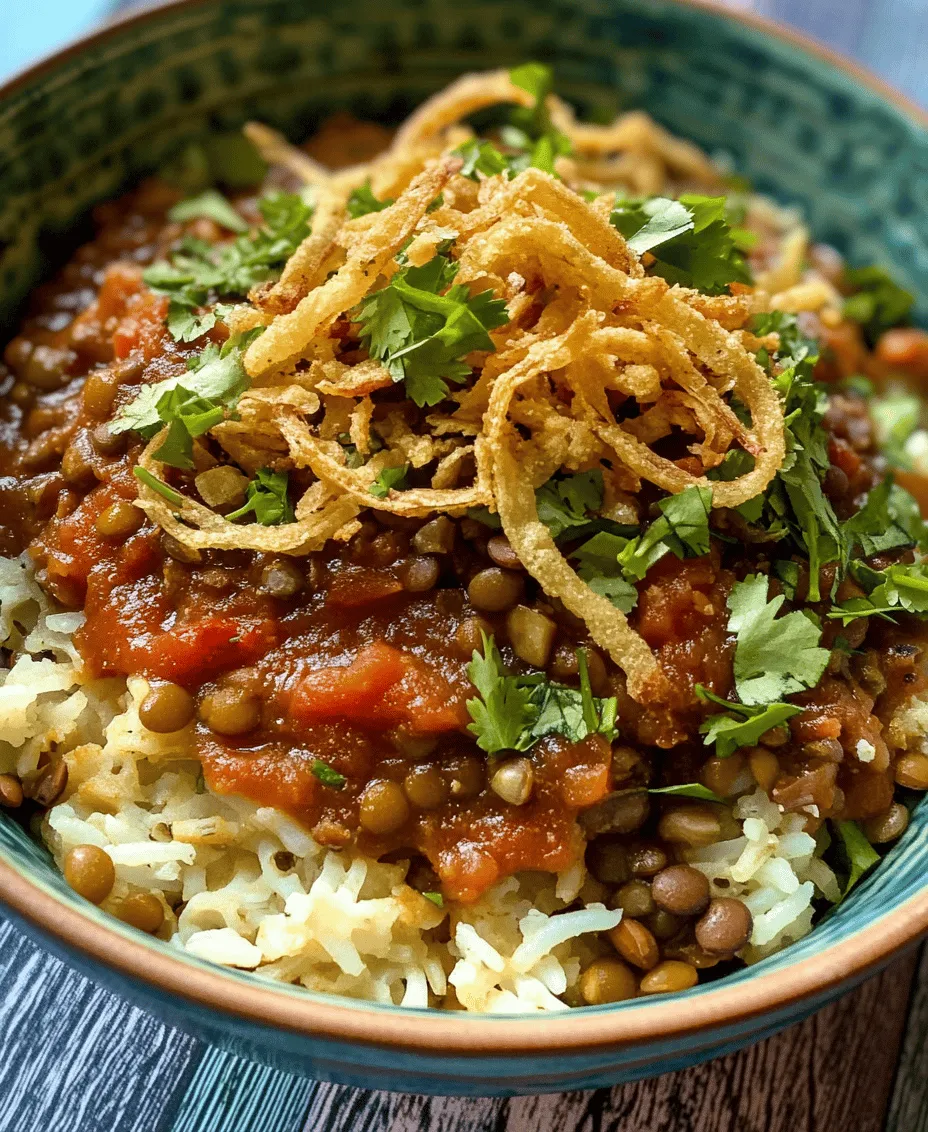Introduction
Koshari is much more than just a dish; it is a culinary symbol of Egypt, often described as the country’s comfort food. Renowned for its hearty and satisfying nature, Koshari brings together an eclectic mix of flavors, textures, and colors, making it a favorite among locals and visitors alike. This beloved dish is a delightful combination of lentils, rice, pasta, and a rich tomato sauce, all topped with crispy fried onions and a sprinkle of spices that elevate its taste to new heights.
The origins of Koshari can be traced back to the 19th century when it emerged as a popular street food among the working class in Cairo. Over time, it transformed into a beloved staple found in homes and restaurants across Egypt. Koshari embodies the essence of Egyptian cuisine, reflecting the country’s rich history and diverse culinary influences from various cultures. This dish is a testament to the resourcefulness of Egyptian cooks who created a meal that is not only filling but also affordable and accessible.
Koshari is typically enjoyed as a main course, often served during special occasions, family gatherings, and even on busy weekdays as a quick and satisfying meal. Its vegetarian nature appeals to a wide range of diets, making it a popular choice for both meat lovers and vegetarians. Packed with nutrients from its wholesome ingredients, Koshari offers a balanced meal that is both delicious and nourishing.
Understanding Koshari: A Cultural Perspective
To truly appreciate Koshari, it is essential to delve into its historical roots and cultural significance. Originally, Koshari was a simple combination of rice and lentils, designed to provide sustenance for the working class. As it gained popularity, street vendors began to offer their unique twists, incorporating pasta and a variety of spices that enhanced its flavor profile. Today, Koshari represents the melting pot of Egyptian society, reflecting influences from Italian, Indian, and Middle Eastern cuisines.
This dish is often associated with comfort and home, frequently served at family gatherings and celebrations. It’s common for families to gather around a large bowl of Koshari, sharing stories and laughter as they enjoy this comforting meal together. The preparation of Koshari can even be a communal activity, with family members coming together to cook, chop, and fry, creating not only a meal but cherished memories.
Koshari’s vegetarian appeal is another reason for its enduring popularity. With the rising interest in plant-based diets, Koshari serves as a nutritious option that is high in protein, fiber, and essential vitamins. Lentils and rice provide a complete protein source, while the dish’s vibrant vegetables contribute to a well-rounded meal. The use of spices like cumin and coriander not only enhances flavor but also offers health benefits, aiding digestion and boosting immunity.
Ingredients Breakdown: The Heart of Koshari
The magic of Koshari lies in its diverse ingredients, each playing a crucial role in creating the dish’s signature flavor and texture. Let’s take a closer look at the components that make Koshari such a loved comfort food.
Lentils
Lentils are a cornerstone of Koshari, providing both protein and fiber. They are rich in nutrients such as iron, folate, and magnesium, making them a staple in Egyptian cooking. The earthy flavor of lentils complements the other ingredients, adding depth to the dish. When cooked, lentils become tender yet maintain their shape, creating a satisfying contrast with the other components of Koshari.
Rice
Rice is another essential ingredient in Koshari, adding a base that ties the dish together. The most commonly used variety is Egyptian short-grain rice, which is known for its sticky texture. This type of rice absorbs the flavors of the spices and sauces beautifully, enhancing the overall taste of the dish. The combination of rice with lentils creates a hearty foundation, ensuring that Koshari is both filling and satisfying.
Pasta
The inclusion of pasta in Koshari is what makes this dish unique. Typically, small pasta shapes like macaroni or ditalini are used, adding a delightful chewiness that contrasts with the softness of the rice and lentils. The pasta serves as a vehicle for the rich tomato sauce, soaking up the flavors and contributing to the dish’s overall comfort. While some variations of Koshari may use different types of pasta, the key is to choose a shape that holds the sauce well.
Onions
Fried onions are an integral part of Koshari, providing a crunchy texture and a burst of flavor. They are typically thinly sliced and deep-fried until golden brown, resulting in a sweet and savory topping that enhances the dish. The crispy onions add a satisfying crunch that contrasts beautifully with the softer components of Koshari, elevating the eating experience.
Garlic and Tomatoes
The aromatic duo of garlic and tomatoes creates the signature sauce that binds Koshari together. Garlic, when sautéed, releases its fragrant oils, infusing the dish with a warm and inviting aroma. Fresh tomatoes, or a combination of fresh and canned tomatoes, are used to create a rich sauce that adds brightness and acidity to the dish. The sauce is seasoned with spices, transforming simple ingredients into a flavorful base that envelops the rice, lentils, and pasta.
Spices
Spices play a critical role in defining Koshari’s flavor profile. The most common spices used include cumin, coriander, and cayenne pepper, each adding its unique character to the dish. Cumin imparts a warm, earthy flavor that complements the lentils and rice, while coriander adds a hint of citrusy freshness. A dash of cayenne pepper introduces a mild heat, elevating the overall taste and making each bite exciting. The careful balance of spices ensures that Koshari is not only delicious but also aromatic.
Vinegar
Vinegar is an essential ingredient in Koshari, providing acidity that balances the richness of the dish. A splash of vinegar in the tomato sauce brightens the flavors and cuts through the heaviness of the lentils and pasta. This acidity is crucial in creating a well-rounded meal, enhancing the overall taste experience.
Garnishes
Finally, garnishes such as fresh cilantro and optional sauces elevate Koshari to another level. Fresh cilantro adds a pop of color and a refreshing herbal note, brightening the dish. Many people also enjoy drizzling their Koshari with a spicy sauce or a tangy garlic sauce, adding layers of flavor and personalizing the dish to their liking. These garnishes not only enhance the visual appeal but also contribute to the overall enjoyment of the meal.
Step-by-Step Cooking Instructions
With a better understanding of Koshari’s rich cultural background and its essential ingredients, we can now delve into the step-by-step cooking instructions that will guide you through the process of making this iconic Egyptian comfort food. The preparation of Koshari may seem intricate due to its various components, but with a little patience and organization, you will create a dish that is both satisfying and rewarding.
1. Prepare the Lentils: Start by rinsing the lentils under cold water until the water runs clear. Place them in a pot with enough water to cover them by about two inches. Bring the water to a boil, then reduce the heat to a simmer. Cook the lentils for about 15-20 minutes, or until they are tender but not mushy. Drain any excess water and set the lentils aside.
2. Cook the Rice: In another pot, rinse the rice under cold water until the water runs clear to remove excess starch. Add the rice to a pot with water (typically, the ratio is 1 cup of rice to 1.5 cups of water) and a pinch of salt. Bring to a boil, then reduce the heat to low, cover, and let it simmer for about 15 minutes or until the rice is fully cooked and water has evaporated. Fluff the rice with a fork and set it aside.
3. Boil the Pasta: Cook the pasta according to the package instructions in a separate pot. Make sure to salt the water for added flavor. Once cooked, drain the pasta and set it aside.
4. Prepare the Tomato Sauce: In a skillet, heat some olive oil over medium heat. Add minced garlic and sauté until fragrant, about 1 minute. Next, add chopped fresh tomatoes (or canned tomatoes) along with spices such as cumin, coriander, and cayenne pepper. Allow the sauce to simmer for about 10-15 minutes, stirring occasionally until it thickens. Adjust seasoning with salt and vinegar to taste.
5. Fry the Onions: In a separate pan, heat oil over medium-high heat for frying the onions. Thinly slice the onions and fry them until they are golden brown and crispy. Use a slotted spoon to remove them from the oil and drain them on paper towels to remove excess grease.
6. Assemble the Koshari: In a large serving bowl, layer the cooked rice, followed by the lentils, pasta, and then pour the tomato sauce over the top. Finally, sprinkle the crispy fried onions as a garnish. You can also add fresh cilantro and any additional sauces at this point for extra flavor.
This marks the beginning of your culinary adventure with Koshari, an iconic dish that will surely delight your taste buds and warm your heart. Each step is a building block toward creating a comforting meal that brings the essence of Egyptian culture right into your kitchen. Stay tuned for the next part, where we will explore additional tips for perfecting your Koshari and answer some common questions about this remarkable dish.

Cooking the Lentils
To start your Koshari, cooking the lentils properly is crucial for achieving the right texture and flavor. Begin by rinsing 1 cup of brown or green lentils under cold water to remove any impurities. Then, place them in a pot and cover them with about 3 cups of water. Bring the water to a boil over medium-high heat, then reduce the heat to low, allowing the lentils to simmer gently.
Cook the lentils for about 20-25 minutes until they are tender but not mushy. It’s essential to monitor them closely as overcooked lentils can turn into a mushy puree, which is not ideal for Koshari. Once cooked, drain any excess water and set the lentils aside, ready to combine with the other components.
Preparing the Rice
Next, it’s time to prepare the rice, which plays a vital role in balancing the flavors of Koshari. Use 1 cup of long-grain rice, such as basmati or jasmine, for a fluffy texture. Rinse the rice under cold water until the runoff is clear to remove excess starch, which can cause the rice to become gummy during cooking.
In a separate pot, heat 1 tablespoon of vegetable oil over medium heat. Add the rinsed rice to the pot and sauté it for about 2-3 minutes until the grains are slightly toasted and fragrant. This step enhances the flavor and helps keep the grains separate.
Next, add 2 cups of water and a pinch of salt to the pot. Bring it to a boil, then cover the pot, reduce the heat to low, and let it simmer for about 15-20 minutes. The water should be fully absorbed, and the rice should be fluffy and tender. Remove the pot from the heat and let it sit, covered, for about 5 minutes before fluffing the rice with a fork.
Cooking the Pasta
For the pasta component of Koshari, you can use small macaroni or any short pasta of your choice. Start by boiling a pot of salted water; once it reaches a rolling boil, add 1 cup of pasta. Cook according to package instructions, typically around 8-10 minutes, until al dente.
To ensure perfect pasta, check for doneness a minute or two before the recommended cooking time. Once cooked, drain the pasta and rinse it briefly with cold water to stop the cooking process. This also helps prevent the pasta from sticking together. Set the pasta aside while you prepare the remaining components of your Koshari.
Frying the Onions
Crispy fried onions are a signature topping for Koshari, adding both texture and flavor. Slice 2 medium onions thinly and soak them in cold water for about 10 minutes. This helps to remove some of their sharpness and allows for even frying.
In a pan, heat about 1 cup of vegetable oil over medium heat. Once the oil is hot, drain the onions and add them to the pan, frying in batches to avoid overcrowding. Fry the onions for about 10-15 minutes, stirring occasionally, until they are golden brown and crispy.
Once done, use a slotted spoon to transfer them to a plate lined with paper towels to absorb excess oil. Season the crispy onions with a pinch of salt while they are still warm to enhance their flavor.
Making the Tomato Sauce
The tomato sauce is the heart of Koshari, bringing all the elements together. Start by heating 2 tablespoons of olive oil in a saucepan over medium heat. Add 2 minced garlic cloves and sauté them for about 30 seconds until fragrant. Next, add 1 can (14 ounces) of crushed tomatoes, 1 tablespoon of tomato paste, and 1 teaspoon of cumin.
Stir the mixture and cook it for about 10-15 minutes, allowing the sauce to thicken slightly. Season with salt, pepper, and a pinch of sugar to balance the acidity of the tomatoes. You can also add a dash of cayenne pepper or chili flakes if you prefer a bit of heat. Taste and adjust the seasoning as needed, then remove the sauce from heat.
Combining Components
To assemble your Koshari, it’s important to layer the components carefully for the best presentation and flavor integration. Start by spooning a generous portion of the cooked rice into a bowl, followed by a layer of lentils and then the pasta on top.
Drizzle a portion of the tomato sauce over the layered ingredients, allowing it to seep down. Finally, finish with a generous sprinkle of crispy fried onions on top. This layering not only looks appealing but also ensures each bite is a harmonious blend of flavors.
Garnishing and Serving
Koshari is best served warm, and you can elevate its presentation by adding fresh herbs. Chopped parsley or cilantro can add a burst of color and freshness. For an extra kick, consider serving with a side of hot sauce or a sprinkle of vinegar, which complements the dish beautifully.
Traditional Koshari is served in bowls, allowing guests to enjoy the mix of textures and flavors. You can also serve it with a side of pickled vegetables for an added crunch and tanginess that contrasts the dish’s richness.
Nutritional Profile of Koshari
Koshari is not just a delicious comfort food; it also packs a nutritional punch. The combination of lentils, rice, and pasta provides a balanced source of carbohydrates, making it a hearty meal. Lentils are rich in protein and fiber, which contribute to a feeling of fullness and aid in digestion.
A serving of Koshari contains approximately:
– Calories: 400-500 (depending on portion size)
– Protein: 15-20 grams
– Carbohydrates: 80-90 grams
– Fiber: 15-20 grams
This dish is especially suitable for vegetarians and those looking to reduce meat intake, as it offers a complete protein profile through the combination of grains and legumes.
Tips for Customizing Koshari
One of the greatest aspects of Koshari is its versatility. Here are some ideas for customizing the recipe to suit your taste preferences or dietary needs:
– Reduce the Heat: If you prefer a milder flavor, reduce the amount of cumin and omit the cayenne pepper from the tomato sauce.
– Add More Vegetables: Incorporate sautéed vegetables, such as bell peppers, carrots, or zucchini, into the layers for added nutrition and flavor.
– Substitute Grains: For a gluten-free option, you can replace the pasta with gluten-free grains like quinoa or brown rice. Just be mindful of the cooking times as they may vary.
– Experiment with Spices: Feel free to add spices like coriander, turmeric, or black pepper to the lentils or rice for additional flavor complexity.
Koshari Around the World
Koshari has gained popularity beyond Egypt, with variations emerging in different regions. In Lebanon, for instance, similar dishes incorporate local spices and ingredients, reflecting the cultural exchange in the Mediterranean.
In some parts of the Middle East, Koshari is served with yogurt or tahini sauce, adding a creamy texture and tanginess that complements the dish perfectly. In Western countries, it has become a popular vegetarian dish, often featured in Middle Eastern restaurants and food festivals.
Koshari’s international appeal lies in its comforting nature and the ability to adapt to various culinary traditions, making it a beloved dish for people around the world.
Conclusion
Koshari is more than just a meal; it represents the rich culinary heritage of Egypt and the warmth of communal eating. This comforting bowl of rice, lentils, pasta, and tomato sauce is a delightful fusion of flavors and textures that can bring people together around the table.
As you prepare this dish, take time to savor each step, from cooking the lentils to frying the onions, knowing that you are creating a dish steeped in tradition. Whether you enjoy it as a hearty family dinner or share it with friends, Koshari is sure to leave a lasting impression. We encourage you to try making Koshari at home and immerse yourself in the vibrant flavors of Egyptian cuisine.



